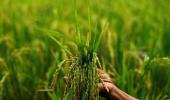Normally, kharif sowing of vegetable seeds starts during the first week of May across the country. Farmers start preparing their fields to make them suitable for kharif sowing during the second fortnight of April.
Now, however, faced with the lockdown, farmers are in a hurry to clear their fields of rabi crop and prepare for kharif planting. With a normal monsoon forecast this year, they are doing all they can to take advantage of pre-monsoon showers.

In a major setback for farmers and consumers alike, vegetable cultivators have started ploughing their fields for kharif sowing despite some 30 per cent of the crops remaining unharvested due to a sharp drop in demand and disruption in marketing infrastructure following the coronavirus lockdown in the country.
Kharif sowing time for vegetables will begin after a week or two.
The situation emerged due to the countrywide lockdown that began on March 25, and was later extended for 19 days to contain spread of the Covid-19 pandemic. A major chunk of the demand was from hotels, restaurants and small eateries, all of which have been forced shut.
The lockdown saw farm workers abstaining from entering the fields for harvesting of rabi fruits and vegetables. Mandi closure and curb on transportation even of essential commodities both inter- and intra-state coupled with reverse migration of daily wage earners has posed a huge problem for farmers engaged in horticulture.
“Farmers have left around 30 per cent of matured rabi crops in the field unharvested due to weak demand, which worsened due to transport restrictions. In the absence of workers, farmers started harvesting matured crops themselves. But, lack of demand and problems in transportation to mandis impacted their earnings. Now, they have started field preparations for kharif sowing,” said Shriram Gadhave, president, Vegetables Growers Association of India (VGAI).
Farmers are in a hurry to clear their fields of rabi crop and prepare for kharif planting. With a normal monsoon forecast this year, they are doing all they can to take advantage of pre-monsoon showers.
Trade sources estimate the rabi season contribution to India’s vegetable and fruit availability at 60-65 per cent, with kharif contributing the rest.
Normally, kharif sowing of vegetable seeds starts during the first week of May across the country. Farmers start preparing their fields to make them suitable for kharif sowing during the second fortnight of April.
“Around 30 per cent of vegetable crops remains unharvested and has been allowed to rot in the fields. Preparations for kharif sowing have already been begun. With rabi sale proceeds dwindling, farmers have been forced to borrow from local moneylenders to buy seeds, fertilisers and other agriculture inputs in addition to paying wages to field workers. This may increase the financial stress on farmers,” said Santosh Patil, Chairman, Agriculture Produce Market Committee (APMC), Sangli.
During the lockdown, many APMCs remained closed despite fruits and vegetables being regarded as essential commodities. On the days that they remained open, arrivals were lower due to farmers’ apprehensions over the quantity they would be able to sale.
Many large individual cultivators, farmers producers organisations (FPOs) and farmers producers companies (FPCs) started selling horticultural produce directly to bulk and retail consumers.
According to Gadhave, the Maharashtra government introduced subsidies such as free electricity and other benefits enable farmers to buy seeds and fertilisers, and also extended them financial support. “But, a lot more needs to be done for the betterment of farmers,” he added.
During this lockdown, Chiku, pomegranate and grapes suffered the most among fruits. Grapes have yet to be harvested in large areas of Nashik and farmers have incurred massive losses. Pomegranate growers are selling at throwaway prices to improve liquidity and clear inventory.
When asked about the possibility of shifting to other remunerative crops, Patil said, “Vegetable farmers would grow veggies only even if the crop is damaged or realisations decline.”
According to him, farmers have started mortgaging jewellery and borrowing at high interest rates from moneylenders, on the condition that they will repay after harvesting the kharif produce.












 © 2024 Rediff.com -
© 2024 Rediff.com -